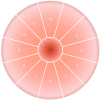Diagnostic test of bioimpedance-based neural network algorithm in early cervical cancer
- PMID: 35571399
- PMCID: PMC9096428
- DOI: 10.21037/atm-22-1366
Diagnostic test of bioimpedance-based neural network algorithm in early cervical cancer
Abstract
Background: Colposcopy is a critical component of cervical cancer screening services, but the accuracy of colposcopy varies greatly due to the lack of standardized training for colposcopists and pathologists. Thus, to improve the accuracy of colposcopy in the detection of cervical lesions intelligently is urgent. Here, we explored the sensitivity and specificity of a bioimpedance-based neural network algorithm in distinguishing normal and precancerous cervical tissues.
Methods: Bioimpedance data were collected using a bioimpedance analyzer (Mscan1.0B, Sealand Technology, Chengdu, China) from the cervices of 102 female patients with abnormal cervical cytology (≥atypical squamous cells of undetermined significance) who required further colposcopy. Finally, the data of 106 samples from 37 patients were included, among which 85were used as the training set and 21 as the validation set. Using the biopsy pathology at each locus as the gold standard, the sensitivity, specificity, predictive value, likelihood ratio, and false positive and false negative rates of the bioimpedance-based neural network in identifying the normal and precancerous cervical tissues were calculated.
Results: The bioimpedance method had a sensitivity of 0.90 [95% confidence interval (CI): 0.54 to 0.99], specificity of 0.82 (95% CI: 0.48 to 0.97), positive predictive value of 0.82 (95% CI: 0.48 to 0.97), and a negative predictive value of 0.90 (95% CI: 0.54 to 0.99) in distinguishing normal and precancerous cervical tissues. The Kappa value was 0.72.
Conclusions: The bioimpedance method was an intelligent method with relative good sensitivity and specificity in distinguishing benign cervical tissue and precancerous lesions and can therefore be used as an adjunctive test to colposcopy to improve the detection of cervical lesions.
Keywords: Bioimpedance; cervical cancer; cervical precancerous lesion; neural network algorithm.
2022 Annals of Translational Medicine. All rights reserved.
Conflict of interest statement
Conflicts of Interest: All authors have completed the ICMJE uniform disclosure form (available at https://atm.amegroups.com/article/view/10.21037/atm-22-1366/coif). YD is an employee of Sealand Technology (Chengdu) Ltd. JL reports funds from HINER CLIENT Technology (Chengdu) Ltd.; employment contract with HINER CLIENT Technology (Chengdu) Ltd.; patents planned, issued or pending of HINER CLIENT Technology (Chengdu) Ltd. XN reports that this study was supported by National Key Research and Development Program of China (Nos. 2021YFC2009100; 2021YFC2009105). The other authors have no conflicts of interest to declare.
Figures





Comment in
-
A promising technique to improve and expand the practice of colposcopy to help the global fight against cervical cancer.Ann Transl Med. 2022 Jul;10(13):723. doi: 10.21037/atm-22-2959. Ann Transl Med. 2022. PMID: 35957735 Free PMC article. No abstract available.
References
-
- World Health Organization. Cervical cancer;(cited 2021 Dec 23). Available online: https://www.who.int/health-topics/cervical-cancer#tab=tab_1
-
- Zhou PR, Zhou WH, Xia L, et al. Research progress of early screening methods for cervical cancer. Journal of Hubei University (Medical Edition) 2020;37:48-51.
LinkOut - more resources
Full Text Sources
